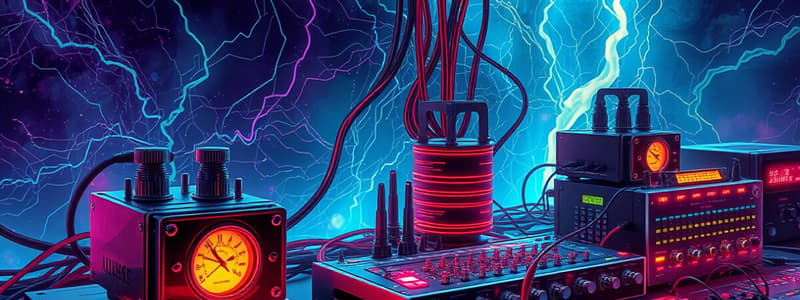Podcast
Questions and Answers
What is the primary use of +12V output voltage?
What is the primary use of +12V output voltage?
- Supplying cooling fans and disk drives (correct)
- Powering floppy disk controllers
- Powering processors
- Providing reference point for ground
-5V output is commonly used in modern systems.
-5V output is commonly used in modern systems.
False (B)
What does the zero-volt ground refer to?
What does the zero-volt ground refer to?
Common or earth
The _____ is a 4-pin power connector that supplies power to the processor.
The _____ is a 4-pin power connector that supplies power to the processor.
Match the following output voltages with their typical use:
Match the following output voltages with their typical use:
Which color wire corresponds to the +5V standby voltage?
Which color wire corresponds to the +5V standby voltage?
The ATX 20-pin connector can be split into a 20-pin connector and a 4-pin connector.
The ATX 20-pin connector can be split into a 20-pin connector and a 4-pin connector.
What color wire indicates a ground connection in a PSU?
What color wire indicates a ground connection in a PSU?
In older types of serial port amplifier circuits, the output voltage used is _____
In older types of serial port amplifier circuits, the output voltage used is _____
What type of power connector is used for IDE disk drives and CD-ROM/DVD drives?
What type of power connector is used for IDE disk drives and CD-ROM/DVD drives?
Floppy disk drives are powered by a Mini-Molex connector.
Floppy disk drives are powered by a Mini-Molex connector.
What is the primary purpose of a SATA connector?
What is the primary purpose of a SATA connector?
The _____ memory is lost when the computer power is off.
The _____ memory is lost when the computer power is off.
Match the following connectors to their primary usage:
Match the following connectors to their primary usage:
Which of the following is NOT considered a secondary storage device?
Which of the following is NOT considered a secondary storage device?
Non-volatile memory is lost when power is removed from the computer.
Non-volatile memory is lost when power is removed from the computer.
Name one example of an input device.
Name one example of an input device.
An example of an output device is a _____
An example of an output device is a _____
What is the main difference between volatile and non-volatile memory?
What is the main difference between volatile and non-volatile memory?
What is the main function of a Power Supply Unit (PSU)?
What is the main function of a Power Supply Unit (PSU)?
The motherboard is often referred to as the brain of the computer.
The motherboard is often referred to as the brain of the computer.
What type of memory is RAM classified as?
What type of memory is RAM classified as?
A ________ is used to store data permanently and is typically nonvolatile.
A ________ is used to store data permanently and is typically nonvolatile.
What does the 'CS' setting indicate in hard disk drives?
What does the 'CS' setting indicate in hard disk drives?
Match the following memory/storage types with their characteristics:
Match the following memory/storage types with their characteristics:
The data bus is responsible for transferring information about where data should go in memory.
The data bus is responsible for transferring information about where data should go in memory.
What is the primary function of the processor (CPU)?
What is the primary function of the processor (CPU)?
What is the function of a PC Card slide in a computer?
What is the function of a PC Card slide in a computer?
A wider bus, such as a __________ bus, can transfer more data at a time.
A wider bus, such as a __________ bus, can transfer more data at a time.
Flash memory cards and USB drives are examples of volatile memory.
Flash memory cards and USB drives are examples of volatile memory.
Match the following types of buses with their descriptions:
Match the following types of buses with their descriptions:
What does HDD stand for?
What does HDD stand for?
The system unit has two types of memory: ________ and nonvolatile.
The system unit has two types of memory: ________ and nonvolatile.
Which of the following statements is true regarding CMOS?
Which of the following statements is true regarding CMOS?
Which component connects the CPU, PCI slot, and RAM together?
Which component connects the CPU, PCI slot, and RAM together?
The CMOS Battery keeps the real-time clock running even when the computer is powered off.
The CMOS Battery keeps the real-time clock running even when the computer is powered off.
What is the purpose of PCI Express x16 slots?
What is the purpose of PCI Express x16 slots?
The ______ connects old HDDs and optical drives for data transfer.
The ______ connects old HDDs and optical drives for data transfer.
Match the following connectors to their descriptions:
Match the following connectors to their descriptions:
Which slot is specifically designed for modern expansion cards?
Which slot is specifically designed for modern expansion cards?
The back panel connector is used solely for internal device connections.
The back panel connector is used solely for internal device connections.
What does the Southbridge component allow the CPU to connect with?
What does the Southbridge component allow the CPU to connect with?
The ______ slot is used for older expansion cards like sound cards and network cards.
The ______ slot is used for older expansion cards like sound cards and network cards.
What is the function of the ATX Power Connector?
What is the function of the ATX Power Connector?
Flashcards are hidden until you start studying
Study Notes
Power Supply Unit (PSU) and Outputs
- High-frequency transformers enable lighter and cheaper DC output.
- Feedback controllers maintain stable output voltage and current, adjusting power based on load with voltage pulse modulation.
- Standard output voltages include -12V, -5V, 0V, +3.3V, +5V, and +12V.
- -12V: Primarily for older serial port amplifier circuits; limited to 1A.
- -5V: Used in early PCs for floppy disk controllers; not common in newer systems, limited to 1A.
- 0V: Ground reference point for voltage systems.
- +3.3V: Powers processors, some memory types, AGP video cards, and digital circuits.
- +5V: Supplies power to motherboards; includes standby voltage for powering system when off.
- +12V: Powers devices with motors, such as disk drives and cooling fans.
Common PSU Connectors
- P1: ATX 20-pin/24-pin connector for motherboard power; splits into 20-pin and 4-pin in some PSU.
- Color coding for P1 connector pins:
- Blue = -12V
- White = -5V
- Black = Ground
- Orange = +3.3V
- Red = +5V
- Yellow = +12V
- Purple = +5V standby
- Green = DC on
- Brown = Sense
- ATX 12V (P4): 4-pin connector supplementing P1 for processor power.
- MOLEX: 4-pin peripheral connector for IDE drives.
- BERG (Mini-MOLEX): 4-pin floppy drive power connector, also for AGP video cards.
- SATA: 15-pin connector for SATA hard drives.
- PCI Express: 6-pin or 8-pin connectors for PCI Express graphic cards.
Basic Hardware Components of a Computer System
- Components: CPU, primary storage, secondary storage, input/output devices, communication devices.
- Primary Storage (Memory): Temporary data and program storage; includes volatile (RAM) and non-volatile (ROM, flash memory).
- Secondary Storage: Permanent data storage outside of the computer, e.g., HDD, USB drives, CDs, DVDs.
- Input Devices: Hardware that inputs data into the computer, e.g., keyboard, mouse, scanner.
- Output Devices: Provides processed information, e.g., printer, monitor, speakers.
- Communication Devices: Enable data exchange over networks, using various transmission media.
Parts of a Motherboard
- Back Panel Connectors and Ports: Connects to external devices (USB, audio, display).
- Expansion Slots: For older (PCI) and modern (PCI Express) expansion cards.
- Northbridge: Connects CPU, PCI slot, and RAM (MCH memory controller hub).
- CPU Socket: Houses the processor.
- Power Connectors: Include ATX 12V and main ATX connectors; provide power to motherboard components.
- Storage Connectors: IDE for older drives, SATA for newer drives.
- Fan Headers: Support system cooling.
Memory and Storage Sizes
- Memory types include volatile (e.g., RAM) and non-volatile (ROM, flash memory).
- Memory Size Units:
- 1 KB = 1024 Bytes
- 1 MB = 1024 KB
- 1 GB = 1024 MB
- 1 TB = 1024 GB
- ROM: Permanent storage; typically non-volatile.
- Firmware: Non-volatile memory, read-only.
- Flash Memory: Non-volatile; retains data without power.
- CMOS: Battery-powered to retain data when off.
Master/Slave Jumper Settings
- Master: Primary drive on the cable.
- Slave: Secondary drive on the same cable.
- Cable Select: Automatically sets drives based on physical position.
- Limit Capacity: For drives exceeding computer handling capacity.
Buses and Communication
- Buses facilitate communication between computer components.
- Data Bus: Transfers actual data.
- Address Bus: Carries memory location information for data transfer.
- Bus Width: Wider buses (e.g., 64-bit) improve data transfer speed.
- Clock Speed: Higher MHz indicates faster data transmission.
- System Bus: Connects CPU to main memory.
- Expansion Bus: Enables communication with peripheral devices.
Common Expansion Buses
- ISA Bus: Older, slower bus for devices like mice and modems.
- PCI Bus: Faster, used for video and sound cards.
- PCI Express (PCIe) Bus: Modern, fast bus for graphics cards and hard disks.
- AGP Bus: Designed for high-speed 3D graphics cards.
Studying That Suits You
Use AI to generate personalized quizzes and flashcards to suit your learning preferences.





